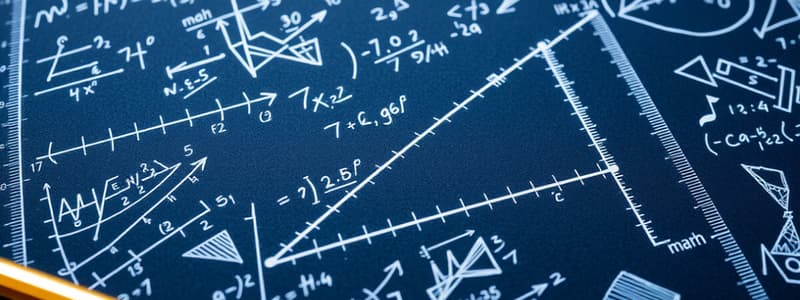Podcast
Questions and Answers
What does factoring a polynomial involve?
What does factoring a polynomial involve?
- Breaking it down into simpler components (correct)
- Finding the roots using derivatives
- Turning it into a linear equation
- Converting it into a quadratic equation
Which trigonometric function is the reciprocal of cosine?
Which trigonometric function is the reciprocal of cosine?
- Tangent
- Cosecant
- Sine
- Secant (correct)
What is the purpose of derivatives in calculus?
What is the purpose of derivatives in calculus?
- To measure how a function changes with respect to its input (correct)
- To define limits of functions
- To solve quadratic equations
- To find the area under curves
In linear algebra, what is the purpose of a determinant?
In linear algebra, what is the purpose of a determinant?
Which operations can be performed on complex numbers?
Which operations can be performed on complex numbers?
What is a key feature of normal distribution in statistics?
What is a key feature of normal distribution in statistics?
Which method is commonly used for numerical integration?
Which method is commonly used for numerical integration?
What do ordinary differential equations (ODEs) involve?
What do ordinary differential equations (ODEs) involve?
Flashcards are hidden until you start studying
Study Notes
Key Concepts in Engineering Mathematics 1
1. Algebra
- Polynomials: Expressions involving variables raised to powers.
- Factoring: Breaking down polynomials into simpler components.
- Quadratic Equations: Solutions using the quadratic formula ( ax^2 + bx + c = 0 ).
2. Trigonometry
- Basic Functions: Sine, cosine, tangent, and their reciprocals.
- Trigonometric Identities: Fundamental formulas such as Pythagorean identities, angle sum and difference identities.
- Inverse Trigonometric Functions: Functions that reverse the trigonometric operations.
3. Calculus
- Limits: Understanding the behavior of functions as they approach specific points.
- Derivatives: Measurement of how a function changes as its input changes; includes rules (product, quotient, chain).
- Integrals: Finding the area under curves; fundamental theorem of calculus connects derivatives and integrals.
4. Differential Equations
- Ordinary Differential Equations (ODEs): Equations involving functions of one variable and their derivatives.
- Applications: Use in modeling physical systems such as motion and heat transfer.
5. Linear Algebra
- Matrices: Rectangular arrays of numbers, used for solving systems of equations.
- Determinants and Inverses: Key concepts for understanding matrix properties and solving linear systems.
- Vector Spaces: Definition, properties, and examples of vector spaces and subspaces.
6. Complex Numbers
- Definition: Numbers of the form ( a + bi ), where ( i ) is the imaginary unit.
- Operations: Addition, subtraction, multiplication, and division of complex numbers.
- Polar Form: Representation of complex numbers in the form ( r(\cos \theta + i \sin \theta) ).
7. Statistics and Probability
- Descriptive Statistics: Measures of central tendency (mean, median, mode) and measures of dispersion (variance, standard deviation).
- Probability Fundamentals: Concepts of events, sample spaces, and basic probability rules.
- Distributions: Normal distribution, binomial distribution, and their properties.
8. Numerical Methods
- Root-finding Methods: Techniques such as the bisection method and Newton-Raphson method.
- Numerical Integration: Approximating the value of integrals using methods like trapezoidal and Simpson's rule.
9. Applications in Engineering
- Modeling and Simulation: Using mathematical models to simulate real-world engineering problems.
- Optimization: Techniques for finding the best solution under given constraints, including linear programming.
Study Tips
- Practice problem-solving regularly to reinforce concepts.
- Use visualization techniques for understanding geometry and calculus.
- Collaborate with peers for group study sessions to discuss complex topics.
Algebra
- Polynomials: Expressions that consist of variables raised to various powers, crucial for many mathematical applications.
- Factoring: The process of decomposing polynomials into simpler, multiplicative components to simplify equations.
- Quadratic Equations: Can be solved using the quadratic formula ( ax^2 + bx + c = 0 ) to find the values of ( x ).
Trigonometry
- Basic Functions: Primary functions include sine, cosine, and tangent, along with their reciprocals: cosecant, secant, and cotangent.
- Trigonometric Identities: Important formulas like Pythagorean identities and angle sum/difference identities that simplify trigonometric expressions.
- Inverse Trigonometric Functions: These functions reverse the effects of the respective trigonometric functions, key for solving equations.
Calculus
- Limits: Fundamental concept that describes the behavior of functions as they approach specific values or points.
- Derivatives: Represent the rate of change of a function with respect to its variable; includes rules such as product, quotient, and chain rule.
- Integrals: Determine the area under curves and are linked to derivatives through the Fundamental Theorem of Calculus.
Differential Equations
- Ordinary Differential Equations (ODEs): Involve functions of one variable and their derivatives, pivotal in various applications.
- Applications: Used to model physical systems, including dynamics of motion and processes like heat transfer.
Linear Algebra
- Matrices: Structured arrangements of numbers enabling the solution of complex systems of equations efficiently.
- Determinants and Inverses: Essential concepts for analyzing matrix properties and solving linear equations.
- Vector Spaces: Collections of vectors, equipped with properties that define their geometric and algebraic structures.
Complex Numbers
- Definition: Comprise numbers in the form ( a + bi ) where ( i ) represents the imaginary unit, broadening the number system.
- Operations: Involves basic arithmetic like addition, subtraction, multiplication, and division applicable to complex numbers.
- Polar Form: Represents complex numbers through ( r(\cos \theta + i \sin \theta) ), facilitating easier calculations in some contexts.
Statistics and Probability
- Descriptive Statistics: Focus on central tendency measures (mean, median, mode) and dispersion measures (variance, standard deviation) for data analysis.
- Probability Fundamentals: Core principles include understanding events, sample spaces, and fundamental probability rules.
- Distributions: Features of distributions like normal and binomial distributions essential for statistical modeling and inference.
Numerical Methods
- Root-finding Methods: Techniques like the bisection method and Newton-Raphson method are essential for finding solutions to equations.
- Numerical Integration: Approaches such as the trapezoidal and Simpson's rule are used to estimate the values of integrals when analytical methods are infeasible.
Applications in Engineering
- Modeling and Simulation: Utilizes mathematical models to represent and analyze real-world engineering problems effectively.
- Optimization: Involves techniques such as linear programming to identify the best outcomes under specified constraints.
Study Tips
- Regularly practice problem-solving to strengthen understanding of concepts.
- Utilize visualization methods to better grasp geometry and calculus topics.
- Engage in group study sessions for collaboration on challenging subjects, enabling deeper insights.
Studying That Suits You
Use AI to generate personalized quizzes and flashcards to suit your learning preferences.




